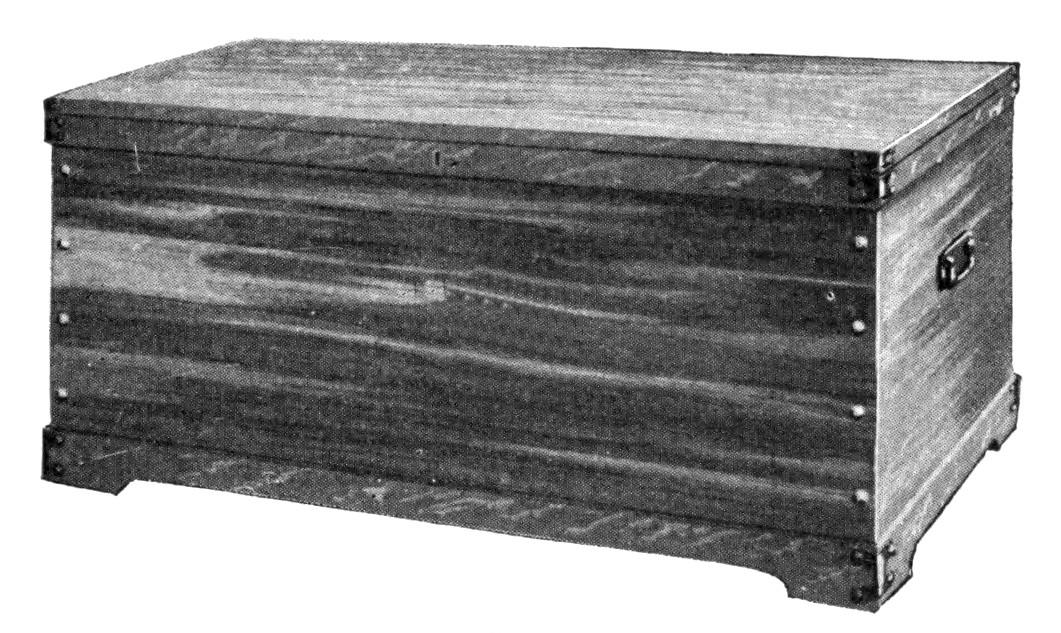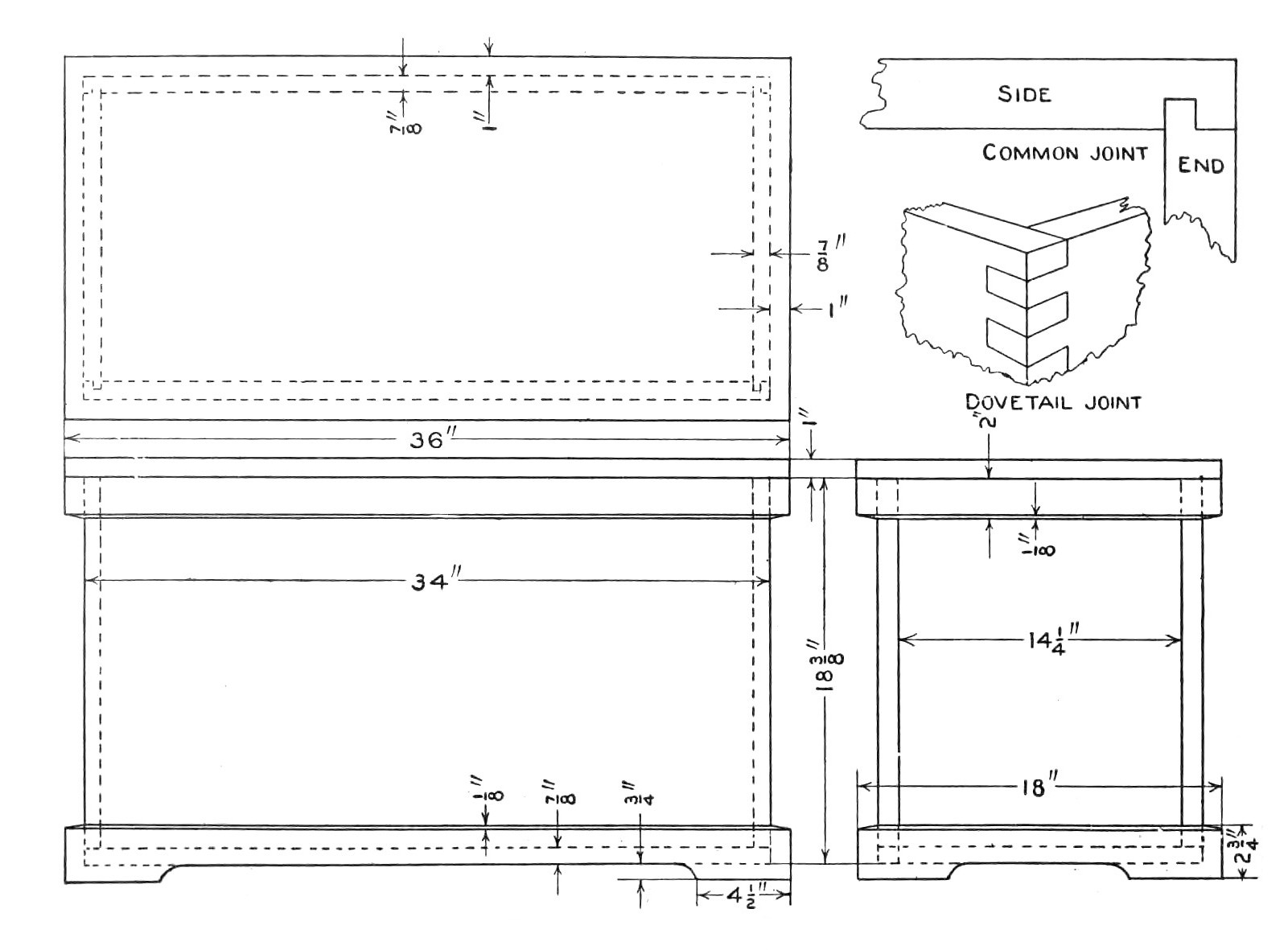AN
OAK-BOUND CEDAR CHEST

This cedar chest
for
storing unused bedding or furs is not a difficult thing to make and
when made, the hard oak binding takes the wear and protects the
softer cedar so that the chest ought to serve several generations.
Order the stock as follows:
CEDAR
2 top and bottom
pieces,
7/8 by 16 1/2
by 34 1/2 in., S-2-S.
2 sides, 7/8 by 18
7/8 by
34 1/2 in., S-2-S.
2 ends, 7/8 by 18
7/8 by
14 1/4 in., S-2-S.
OAK
2 overhanging top
pieces,
1 by 1 by 36 1/2 in., S-4-S.
2 overhanging top
pieces,
1 by 1 by 18 1/2 in., S-4-S.
2 lock and hinge
rails. 1
by 2 1/2 by 36 1/2 in., S-2-S.
2 lock and hinge
rails, 1
by 2 1/2 by 18 1/2 in., S-2-S.
2 base pieces, 1 by
3 1/4
by 36 1/2 in., S-2-S.
2 base pieces, 1 by
3 1/4
by 18 1/2 in., S-2-S.
Specify
thoroughly
seasoned Tennessee red cedar and plain sawed white oak and have the
different pieces millplaned and sandpapered as indicated in the
stock-bill. This bill allows 1/2 in. extra on the length and the
width of each piece for "squaring up" 9f all pieces except
those marked to be surfaced on four sides.

Details
of Cedar Chest
Begin by
squaring the
sides and ends to size. Probably the best joint for the corners is
the dovetail. If the worker is not experienced in woodworking, some
of the more simple joints will do. It will be noted that the drawing
and stock-bill call for the simplest form of joint, that in which the
sides of the chest lap over the end. For the dovetail joint it will
be necessary to add 2 in. more to the length of the end pieces,
making them 16 3/4 in. each in the rough.
Having got the
sides and
ends ready, fasten them together. The perspective shows the sides
fastened to the ends with ornamental headed nails. Common nails are
first used, being equally spaced, and the ornamental heads are
afterwards placed so as to cover their heads.
Next square the
bottom
and nail it to the parts just assembled. Square the top to the same
size.
The base stuff
is squared
on one edge only. The second edge — the upper one — is to be
beveled or sloped 1/8 in. to facilitate dusting and for appearance
sake. Fit these base pieces to place, mitering the joints. Before
fastening the parts to the chest proper, gauge a line 3/4 in. from
the lower edge and to a point 4 1/2 in. from each end, cut out to
this line and shape the base as shown in the drawing. Use finishing
nails for fastening the base to the chest. The heads should be "set"
so they may be covered later with a putty colored to match the
finish.
In a similar
manner plane
up, cut and fit the back and hinge rails. These rails should be kept
a "scant" 1/8 in. below the top edges of the chest proper.
The overhang of the lid fits down over in such a way as to form a
dust-proof joint between lid and chest proper.
The overhang of
the lid
of 1 in. by 1 in. stock may next be mitered, fitted and nailed to the
lid. Thoroughly sandpaper all parts not so treated and finish as
follows: Put on all the oak pieces, two coats of natural paste
filler. This is best done before they are fastened in place.
Directions will be found on the cans in which the filler is kept.
The red of the
cedar may
be heightened by applying a mahogany stain made of Bismark brown
aniline and boiling water, in the proportion of 3 qt. of water to 1
oz. of aniline. If applied hot the stain will enter the wood better.
When dry, sandpaper lightly with No. 00 paper, both this and the
oak-filled pieces.
Fasten the oak
pieces in
place and give the whole exterior a very thin coat of shellac. After
this has hardened, apply two coats of wax. Wax comes in paste form
and is to be applied with a cloth very sparingly. Allow it to stand
five or ten minutes then rub briskly with a soft dry cloth to polish.
The first coat is allowed to stand 24 hours before the second is
applied in a similar manner.
Another finish,
known as
an egg-shell gloss shellac finish, is obtained by omitting the wax
and instead applying from two to five more coats of shellac. Allow
each coat 24 hours in which to harden, and rub each hardened coat to
a smooth finish, using curled hair, or fine steel wool, or fine oiled
sandpaper, before applying the next.
The metal
reinforcements
for the corners can be bought at a hardware store, as can the lock,
hinges, and handles. These parts are applied in the usual manner —
butt hinges being used.
If well made,
the chest
is practically airtight. The interior is all of red cedar, while the
effect of the exterior in combining the light oak and the red cedar
is striking.
|

